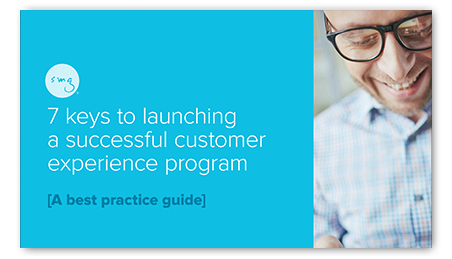What is a Customer Experience Management Strategy—and How Do I Build One?
Published on Jan 20, 2022

You may have an idea of where you are in delivering on customer expectations, and you may have an idea of where you'd like to end up, but do you know how to get there? Or how to keep from getting distracted by issues that pop up along the way?
Your customer experience management strategy is the roadmap you need to get your customer experience (CX) on the right track. It will help inform and evolve your current CX efforts into the ultimate goal of improved success, customer satisfaction, and business outcomes.
Having this framework in place puts you in control and gives your team focus. But there are many things you need to consider when building and implementing a customer experience management strategy. Here are some questions you’ll want to keep in mind:
What is a Customer Experience Management Strategy?
Gartner® defines customer experience management as: “The discipline of understanding customers and deploying strategic plans that enable cross-functional efforts and customer-centric culture to improve satisfaction, loyalty and advocacy.”
When this discipline is put into action, brands have access to actionable customer data that drives business performance at the location and brand level. But when it comes to selecting a customer experience partner, remember a technology platform only gets you part of the way there. The addition of partnership, service, and operator support gets you all the way there.
This collaborative approach will help you overcome common program pitfalls, including:
- The experience management program becoming siloed in one department
- Program owners being protective over decisions about the customer experience
- Departments not having clear ownership or understanding of how they impact CX
- Lack of buy-in among executives, resulting in loss of trust in the customer voice at all levels
- Defensive culture that would rather make excuses for negative feedback rather than make improvements
- Overly ambitious action plans that result in a lack of focus
Achieving CX Program Maturity
Ultimately, your goal is to build an experience management program that delivers maximum business impact. To achieve this program maturity, your XM partner should work with you to create a phased approach with tactical prioritization dedicated to the continual advancement of your program.

Create a CX strategy built to achieve long-lasting impact
What Makes a Good CX Strategy?
The fact is, a customer experience strategy is only as good as its objectives, and the process of establishing objectives is all about setting targets and applying insights to get you incrementally closer to success. However, your objective has to be more focused than “do better,” and it needs to affect the entire organization.
Aligning with Business Goals
There are all kinds of ways a program can have impact, but it ultimately has to deliver ROI to secure organizational buy-in. You need to be able to show key stakeholders your CX strategy is more than just improving scores—it's driving outcomes and real change in your business.
To do this, be sure to align your efforts with these 4 business goals:
Generating New Revenue
Success (and survival) rely on being future-focused. History tells us it’s simply not enough to maintain. Brands must steadily seek ways to attract more customers, open more channels, and offer better products. It’s about uncovering new ways of doing business that open new streams of revenue. Customer feedback makes it possible—providing necessary perspective on what works, what doesn’t, and what you must do to move your brand forward.
Increasing Existing Revenue
Challenge the status quo of customer loyalty. Create fierce advocates for your brand and find ways to broaden and deepen every interaction. Consumers and employees want to stick with what works, putting their time, energy, and dollars toward brands they love. By listening to their hearts, you can move your organization toward a lifetime of reliable brand loyalty (not to mention a rising bottom line).
Reducing Churn and Detractors
There’s a certain amount of loss every business must stomach. It’s what you do with that loss that determines whether you’ll move forward. In this case, ignorance isn’t an excuse; instead it denies you a successful future. But with the right tools in place, brands have the chance to save at-risk revenue, recover lost customers, and curb employee churn. Open every door (and window) for feedback and be willing to make changes based on that feedback.
Driving Operational Efficiencies
It’s up to you to make your business run better, faster, and more efficiently. When your data directs you to the right levers to pull and the right changes to make, you can redefine what it means to serve your customers. Not only does that mean more positive interactions with consumers, it means more satisfied employees who can recognize shifts toward making their jobs easier. And all of it can lead to reduced costs to operate. You’ll be leaner, stronger, and better equipped for the future.
Do You Need External Help?
As a leader, it's your responsibility to create value for your customers and steer your team toward new ways of serving your buyers. During challenging times, you may need to ask yourself—to grow the business, exceed customer's expectations and scale up—is this the right time to outsource your CX program to an experienced partner?
The demand for CX outsourcing has grown in recent years thanks to the increasing investment in customer experience tools. It's easier than ever for companies to deliver the tools and provide access to on-demand experts—providing brands with the freedom to scale their workforce and CX program up and down as necessary.
Benefits of CX Outsourcing
Outsourced partnerships can also help you challenge the status quo and provide flexibility and on-demand expertise. CX partners are focused on assisting clients in evolving and adapting to rapidly changing geopolitical conditions as they seek value-added services and high-impact business outcomes.
When to Consider CX Outsourcing
If you’re considering outsourcing your CX program, exploring new methodologies, or need help justifying the value of a CX program, check out this article: 5 elements of a strong CX team and why outsourcing your program might make sense.
Related articles

How customer obsession helps insights-driven brands outpace the competition
Discover the transformative power of customer obsession in the business world. Dive into our new blog to explore how brands can transition to an insights-driven approach, where every decision is guide

The art of competitive benchmarking: Outmaneuvering the competition
Discover the transformative power of customer obsession in the business world. Dive into our new blog to explore how brands can transition to an insights-driven approach, where every decision is guide

Restaurant trends on a platter—a preview of spending + tipping attitudes
Discover the transformative power of customer obsession in the business world. Dive into our new blog to explore how brands can transition to an insights-driven approach, where every decision is guide